Householder permitted development rights: guidance - updated 2021
Guidance explaining householder permitted development rights and what can be built without submitting a planning application.
4. Making changes to a dwellinghouse
4.1 The relevant permitted development rights for the main types of householder developments are explained within this section.
4.2 Permitted development rights for the different types of development are described within a "class". Most classes are subject to limitation and restrictions. The main householder classes are grouped into the following categories:
- Enlarging a dwellinghouse
- Improvements, additions or other alterations to a dwellinghouse that are not an enlargement
- Other developments within the curtilage of a dwellinghouse
4.3 Permitted development rights for flats are detailed in Section 5.
4.4 Section 6 details permitted development rights for microgeneration and Section 7 details the regulations for CCTV.
4.5 All the limitations within a class must be complied with. In addition, permitted development rights are removed if the proposed development is to create or materially widen a means of access to a trunk road or classified road or creates an obstruction that is likely to causes a hazard for people using the road.
Introduction to Enlarging a Dwellinghouse
4.6 It is important to understand the definition of enlargement. Enlargement is defined as any development that increases the internal volume of the original dwellinghouse and includes a canopy or roof, with or without walls, which is attached to the dwellinghouse, but does not include a balcony. Therefore, a car-port is an enlargement but a balcony is not.
4.7 There are many types of enlargements. The following 4 classes cover the most common types of enlargements for dwellinghouses.
Single storey ground floor extension
Class 1A - Any enlargement of a dwellinghouse by way of a single storey ground floor extension, including any alteration to the roof required for the purpose of the enlargement.
This class covers the typical single storey extension to the rear of the property. Typical developments include conservatories, car-ports as well as other canopies or roofs, with or without walls.
Ground floor extension of more than one storey
Class 1B - Any enlargement of a dwellinghouse by way of a ground floor extension consisting of more than one storey including any alteration to the roof required for the purpose of the enlargement.
This class covers the typical 2 storey extension. The limitations set a minimum distance of 10 metres between the extension and any boundary, since many 1½ storey and 2 storey extension are more likely to have a greater impact than a single storey extension. It is recognised that the majority of extensions will not be able to meet this criteria, therefore an application for planning permission would be required in most instances.
Porch
Class 1C - The erection, construction or alteration of any porch outside any external door of a dwellinghouse.
This class allows for the construction of a small porch on any external door.
Enlargement of the roof
Class 1D - Any enlargement of a dwellinghouse by way of an addition or alteration to its roof.
This class allows for the construction of a typical rear facing dormer.
4.8 These permitted development rights do NOT apply to flats.
4.9 If the proposed development falls into any of the above classes and is in a conservation area then an application to the planning authority is required. Furthermore, if the dwellinghouse was created under permitted development rights granted by classes 18B or 22A then a planning application is required.
4.10 A listed building consent is required if the proposed development affects the character or setting of a listed building. A building warrant from the local authority is also often required, as explained in Section 2.
Single storey ground floor extensions
Summary
4.11 This is the most popular type of development. Permitted development rights allow the enlargement of a dwellinghouse by a single storey ground floor extension. The permitted development rights allow any alteration to the roof required for the purpose of the enlargement. In summary, the effect of the limitations is that:
- extensions are generally located to the rear
- if the extension is on, or within 1 metre of the boundary, it cannot project, from the rear wall of the existing dwellinghouse, by more than 3 metres in the case of terraced house, or 4 metres in all other cases
- the height of the eaves is a maximum of 3 metres
- the height of the extension is not higher than 4 metres
- the footprint of the extension is no larger than the original dwellinghouse or covering more than half the curtilage
4.12 There are no permitted development rights for single storey ground floor extensions in conservation areas or for flats. Nor are there any permitted development rights for ground floor extensions for a dwellinghouse created by class 18B or 22A.Listed building consent will normally be required if your building is Listed.
4.13 A building warrant from the local authority will likely be required for this type of extension, as explained in Section 2.
Technical Explanation
4.14 If the extension exceeds any of the following limits then an application for planning permission is required.
4.15 Roof alterations relating to the extension are also permitted. Other roof alterations should be carried out using the other relevant permitted development classes.
4.16 The extension cannot be forward of a wall forming part of the principal elevation or side elevation if that elevation is fronting a road. The identification of the principal elevation and side elevations are discussed in paragraphs 3.2 - 3.6, whilst fronting a road is discussed at 3.7 - 3.10. This is illustrated in figure 13.
Figure 13: The shaded areas of the curtilage indicate where a single storey extension is permitted as long as the other limitations are met.
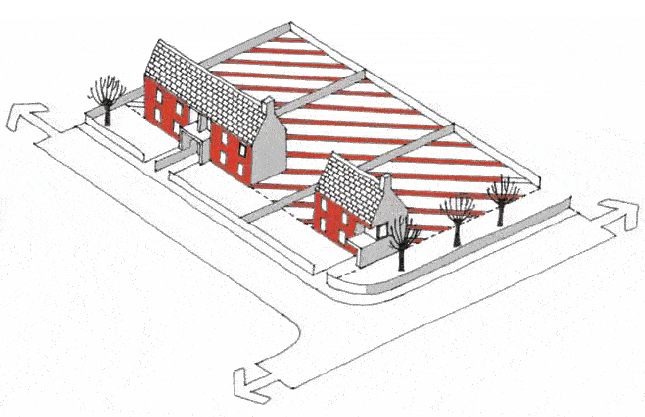
4.17 If any part of the extension is within 1 metre of the boundary of the curtilage, it can only project from the line of the rear elevation nearest to the boundary by 3 metres if a terraced house or 4 metres in any other case.
4.18 This restriction does not apply to a side extension that does not project beyond the line of the rear elevation. For example if a side extension, does extend beyond the line of the rear wall and is within 1 metre of the rear wall and is within 1 metre of the boundary, then it cannot project from the rear wall nearest the boundary by more than 3 metres if a terraced house or 4 metres in any another case.
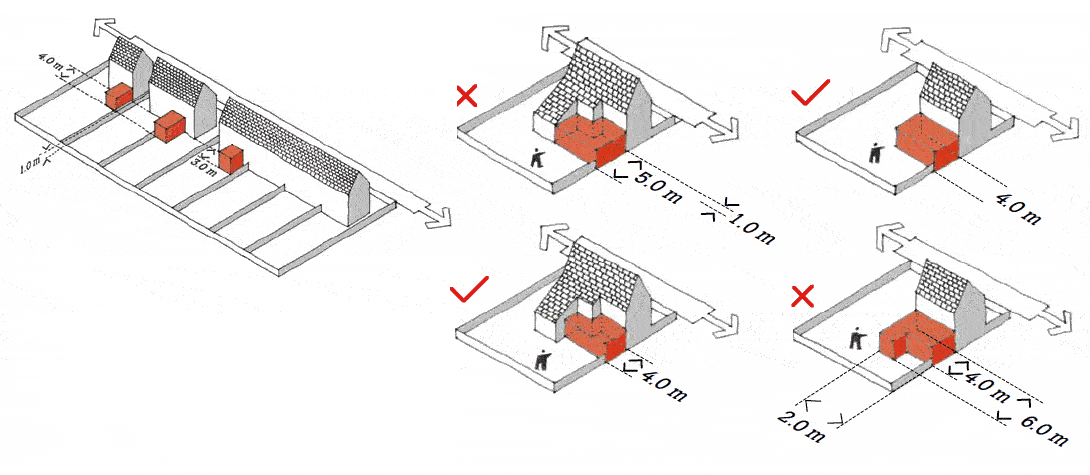
4.19 The overall height of an extension can have a significant impact on neighbours. The eaves of the extension cannot be higher than 3 metres. The overall height of the extension cannot exceed 4 metres.
4.20 When measuring the height of the extension on sloping, or uneven ground, the height should be measured from the lowest point immediately adjacent to the extension.
4.21 The area covered by all extensions, including any existing and the proposed extension, cannot be greater than the footprint of the original dwellinghouse. This is to ensure that the extension (including previous extensions) is in proportion to the original dwellinghouse.
4.22 The proposed extension (including previous extensions) and existing developments cannot exceed half of the of the rear (or front if appropriate) curtilage of the original dwellinghouse. This is explained further in paragraphs 3.12 - 3.13.
4.23 There are no Class 1A permitted development rights in a conservation area or for flats or for dwellinghouses created by class 18B or 22A. A listed building consent is required if the proposed extension affects the character or setting of a listed building.
4.24 Planning authorities will be able to confirm whether a property is located within a conservation area. Information on listed buildings is available from http://www.historic-scotland.gov.uk/historicandlistedbuildings or www.environment.scotland.gov.uk.
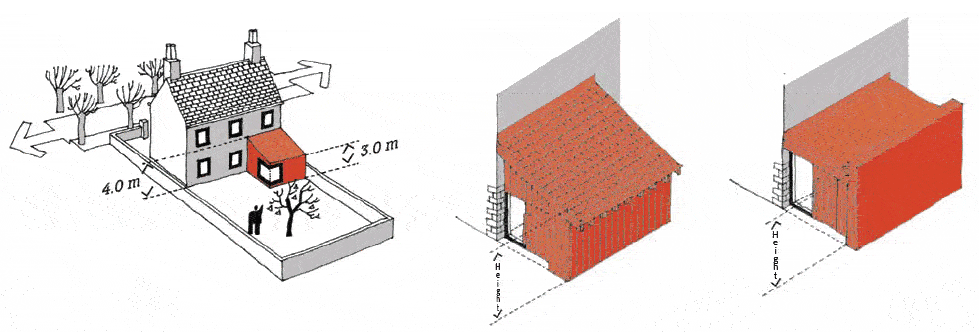
Legislation
Class 1A.-
(1) Any enlargement of a dwellinghouse by way of a single storey ground floor extension, including any alteration to the roof required for the purpose of the enlargement.
Development is not permitted by this class if-
(za) the dwellinghouse is a dwelling by virtue of a change of use permitted under class 18B or 22A;
(a) any part of the development would be forward of a wall forming part of the principal elevation or side elevation where that elevation fronts a road;
(b )any part of the development would be within 1 metre of the boundary of the curtilage of the dwellinghouse and it would extend beyond the line of the wall forming part of the rear elevation that is nearest that boundary by more than—
(i) 3 metres in the case of a terrace house; or
(ii) 4 metres in any other case;
(c) the height of the eaves of the development would exceed 3 metres;
(d) any part of the development would exceed 4 metres in height;
(e) as a result of the development the area of ground covered by the resulting dwellinghouse would be more than twice the area of ground covered by the original dwellinghouse;
(f) as a result of the development the area of ground covered by development within the front or rear curtilage of the dwellinghouse (excluding the original dwellinghouse and any hard surface or deck) would exceed 50% of the area of the front or rear curtilage respectively (excluding the ground area of the original dwellinghouse and any hard surface or deck); or
(g) it would be within a conservation area.
Ground floor extension of more than a one storey
Summary
4.25 Permitted development rights allow the enlargement of a dwellinghouse by the way of a ground floor extension consisting of more than one storey. The permitted development rights also allow any alteration to the roof required for the purpose of the enlargement. In summary, the effect of the limitations is that:
- extensions are generally located to the rear
- the distance between the extension and any boundary is a minimum of 10 metres
- the height of the extension is not higher than the existing dwellinghouse
- the footprint of the extension is not larger than the original dwellinghouse or covering more than half the curtilage
4.26 Many 1½ storey and 2 storey extensions are more likely to have a greater impact than a single storey extension. It is recognised that the majority of 1½ storey and 2 storey extensions will require an application for planning permission.
4.27 There are no permitted development rights in conservation areas or for flats. Nor are there any permitted development rights for ground floor extensions for a dwellinghouse created by class 18B or 22A. Listed building consent will normally be required if your building is Listed.
4.28 A building warrant from the local authority will be required for this type of extension, as explained in Section 2.
Technical Explanation
4.29 If the extension exceeds any of the following limits then an application for planning permission is required.
4.30 The extension cannot be forward of a wall forming part of the principal elevation or side elevation if that elevation is fronting a road. The identification of the principal elevation and side elevations are discussed in paragraphs 3.2 - 3.6, whilst fronting a road is discussed at 3.7 - 3.10. This is illustrated in figure 14.
Figure 14: The shaded areas of the curtilage indicate where an extension of more than a single storey is permitted as long as the other limitations are met.
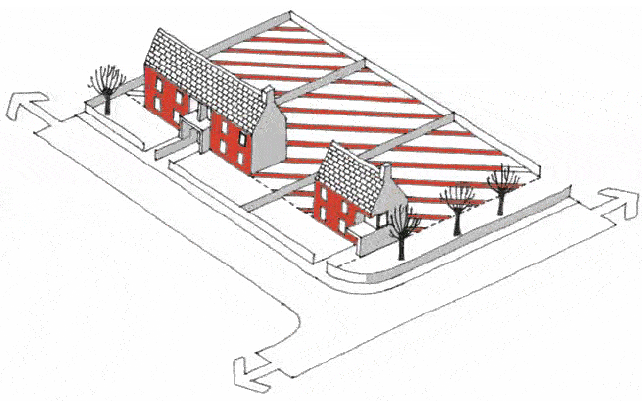
4.31 1½ storey or 2 storey extensions are more likely to have a visual impact, potentially causing overshadowing or overlooking. No part of the extension can therefore be within 10 metres of any boundary of the curtilage.
4.32 The overall height of the extension cannot be higher than the existing roof. This would be the ridge of the roof. Roof alterations relating to the extension are also permitted. Other roof alterations should be carried out using the other relevant classes.
4.33 The area covered by all extensions, including any existing and the proposed extension, cannot be greater than the footprint of the original dwellinghouse. This is to ensure that the extension (including previous extensions) is in proportion to the original dwellinghouse.
4.34 The proposed extension (including previous extensions) and existing developments cannot exceed half of the rear (or front if appropriate) curtilage of the original dwellinghouse. This is explained further in paragraphs 3.11 - 3.13.
4.35 There are no Class 1B permitted development rights in a conservation area or for flats or for dwellinghouses created by class 18B or 22A. A listed building consent is required if the proposed extension affects the character or setting of a listed building.
4.36 Planning authorities will be able to confirm whether a property is located within a conservation area. Information on listed buildings is available from http://www.historic-scotland.gov.uk/historicandlistedbuildings or www.environment.scotland.gov.uk.
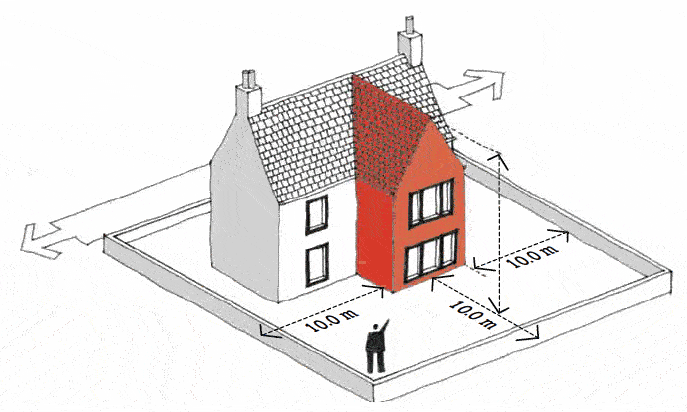
Legislation
Class 1B.-
(1) Any enlargement of a dwellinghouse by way of a ground floor extension consisting of more than one storey, including any alteration to the roof required for the purpose of the enlargement.
Development is not permitted by this class if-
(za) the dwellinghouse is a dwelling by virtue of a change of use permitted under class 18B or 22A;
(a) any part of the development would be forward of a wall forming part of the principal elevation or side elevation where that elevation fronts a road;
(b) any part of the development would be within 10 metres of the boundary of the curtilage of the dwellinghouse;
(c) as a result of the development the height of the dwellinghouse would exceed the height of the existing dwellinghouse, when measured at the highest part of the roof and excluding any chimney;
(d) as a result of the development the area of ground covered by the resulting dwellinghouse would be more than twice the area of ground covered by the original dwellinghouse;
(e) as a result of the development the area of ground covered by development within the front or rear curtilage of the dwellinghouse (excluding the original dwellinghouse and any hard surface or deck) would exceed 50% of the area of the front or rear curtilage respectively (excluding the ground area of the original dwellinghouse and any hard surface or deck); or
(f) it would be within a conservation area.
Porch
4.37 Permitted development rights allow the erection, construction or alteration of any porch outside any external door of a dwellinghouse. The limitations are:
- the porch cannot have a footprint of greater than 3 square metres
- the minimum distance between the porch and any boundary and a road is more than 2 metres
- the height of the porch cannot be higher than 3 metres
4.38 If the porch exceeds any of the above limits then an application for planning permission is required.
4.39 There are no permitted development rights for porches in a conservation area or for a flat or for dwellinghouses created by class 18B or 22A. A listed building consent is required if the proposed extension affects the character or setting of a listed building.
4.40 Planning authorities will be able to confirm whether a property is located within a conservation area. Information on listed buildings is available from http://www.historic-scotland.gov.uk/historicandlistedbuildings or www.environment.scotland.gov.uk
4.41 A building warrant from the local authority may be required for porches, as explained in Section 2.
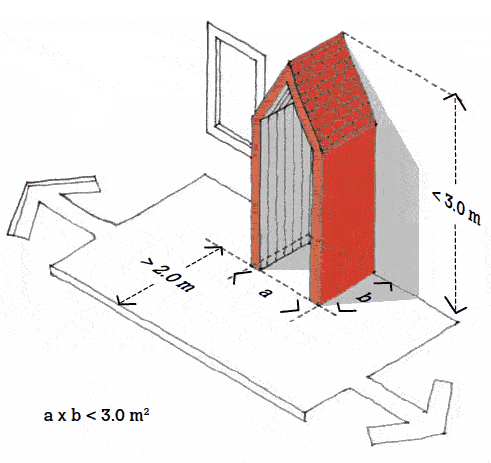
Legislation
Class 1C.-
(1) The erection, construction or alteration of any porch outside any external door of a dwellinghouse.
Development is not permitted by this class if-
(za) the dwellinghouse is a dwelling by virtue of a change of use permitted under class 18B or 22A;
(a) its footprint would exceed 3 square metres;
(b) any part of it would be within 2 metres of a boundary between the curtilage of the dwellinghouse and a road;
(c) any part of the development would exceed 3 metres in height; or
(d) it would be within a conservation area.
Summary
4.42 Permitted development rights allow the enlargement of a dwellinghouse by way of an addition or alteration to its roof. This class typically relates to the addition of a dormer. A badly designed dormer can harm the appearance of a dwellinghouse. The larger the dormer, the more challenging it is to produce a good design. In summary, the effect of the limitations is that:
- dormers are generally located to the rear
- the distance between the dormer and boundary it fronts is a minimum of 10 metres
- the height of the dormer is not higher than the existing dwellinghouse
- the dormer, or dormers, covers less than half the roof
- the distance between the dormer and the edge of the roof is a minimum of 0.3 metres
4.43 There are no permitted development rights to enlarge a roof in a conservation area or a flat or for dwellinghouses created by class 18B or 22A. . Listed building consent will normally be required if your building is Listed.
4.44 Building standards may apply and a building warrant from the local authority may be required for this type of development as explained in Section 2.
Technical Explanation
4.45 If the development exceeds any of the following limits then an application for planning permission is required.
4.46 Figure 15 overleaf illustrates the restrictions for a dormer, the highlighted areas indicate where the development is not permitted as long as the other limitations are met.
4.47 There are no permitted development rights in a conservation area or for flats or for dwellinghouses created by class 18B or 22A. A listed building consent is required if the proposed development affects the character or setting of a listed building.
4.48 Planning authorities will be able to confirm whether a property is located within a conservation area. Information on listed buildings is available from www.historic-scotland.gov.uk/historicandlistedbuildings or www.environment.scotland.gov.uk.
4.49 The development cannot be part of the roof forming the principal elevation or side elevation if that elevation is fronting a road. The identification of the principal elevation and side elevations are discussed in paragraphs 3.2 - 3.6, whilst fronting a road is discussed at 3.7 - 3.10.
4.50 Any enlargement or alteration to a roof is likely to have a visual impact and potentially cause overlooking. The development must be at least 10 metres from the boundary that it fronts.
4.51 The dormer must not exceed half the width of the roof plane (the width of the roof plane is measured at the eaves line). The development must be at least 0.3 metres from the edge of the roof plane, for example the ridge of the roof or the edge of a hipped roof.
4.52 The overall height of the dwellinghouse cannot be increased as a result of the development. This is measured against the existing ridge of the roof.
Figure 15: Roof enlargements
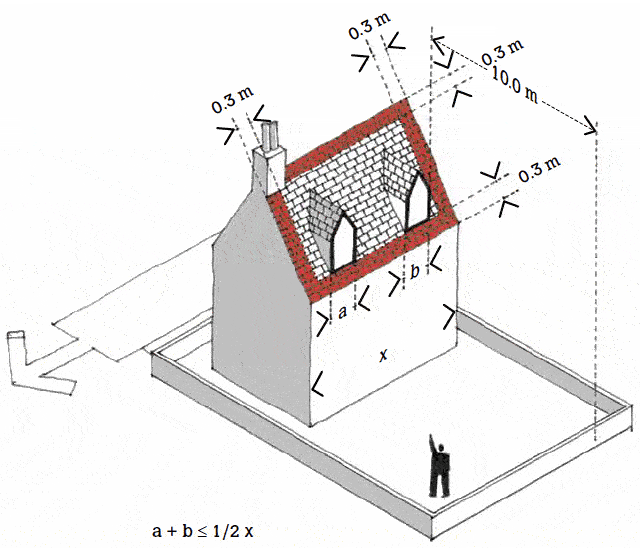
Legislation
Class 1D.-
(1) Any enlargement of a dwellinghouse by way of an addition or alteration to its roof.
Development is not permitted by this class if-
(za) the dwellinghouse is a dwelling by virtue of a change of use permitted under class 18B or 22A;
(a) it would be on a roof plane forming part of the principal elevation or side elevation where that elevation fronts a road;
(b) it would be on a roof plane and would be within 10 metres of the boundary of the curtilage of the dwellinghouse which that roof plane fronts;
(c) as a result of the development the height of the dwellinghouse would exceed the height of the existing dwellinghouse, when measured at the highest part of the roof and excluding any chimney;
(d) its width would exceed half the total width of the roof plane, measured at the eaves line, of the dwellinghouse;
(e) any part of the development would be within 0.3 metres of any edge of the roof plane of the dwellinghouse; or
(f) it would be within a conservation area.
Introduction to improvements, additions or alterations to a dwellinghouse that are not an enlargement
4.53 There are many types of alterations or improvements to a dwellinghouse that are not enlargement. The most common types of alterations or improvements to a dwellinghouses are described in classes 2A and 2B.
Access Ramps
Class 2A - The erection, construction or alteration of any access ramp outside any external door of a dwellinghouse.
This class allows small ramps to be attached to any external door of dwellinghouse so long as certain limitations are met. The ramp is not longer than 5 metres and the overall length of ramp and landings is not longer than 9 metres. The ramp is not higher than 0.4 metres and the combined height of the ramp and any handrail does not exceed 1.5 metres.
Improvements or alterations that are not an enlargement, including replacement windows, solar panels, flues and satellite dishes etc
Class 2B - Any improvement, addition or other alteration to the external appearance of a dwellinghouse that is not an enlargement.
This class is best visualised as a 1 metre bubble surrounding the walls and roof of a dwellinghouse. A householder can add a wide range of different types of development without having to apply for planning permission.
Wind turbines, balconies, raised terraces or platforms are not permitted by this class.
4.54 These permitted development rights do NOT apply to flats.
4.55 If the proposed development falls into any of the above classes and is in a conservation area then an application to the planning authority is required.
Access Ramps
4.56 Permitted development rights allow the erection, construction or alteration of any access ramp outside any external door of a dwellinghouse. The limitations are:
- the length of all flights cannot be more than 5 metres
- the length of all flights and landings cannot be more than 9 metres
- the height of the access ramp, including associated handrails, cannot be higher than1.5 metres
- the height of the platform cannot be higher than 0.4 metres
4.57 If the access ramp exceeds any of the above limits, or is in a conservation area, or within the curtilage of a listed building, then an application for planning permission is required. Listed building consent is required if the proposed access ramp affects the character or setting of a listed building.
4.58 Scottish Building Standards require ramps to be safe. Supporting guidance, including information on suitable gradients and lengths of ramp, can be found in section 4.3 of the Scottish Building Standards Technical Handbook available from www.scotland.gov.uk/bsd.
4.59 Planning authorities will be able to confirm whether a property is located within a conservation area. Information on listed buildings is available from www.historic-scotland.gov.uk/historicandlistedbuildings or www.environment.scotland.gov.uk.
4.60 When measuring the height of the development on sloping or uneven ground, the height should be measured from the lowest point immediately adjacent to the ramp.
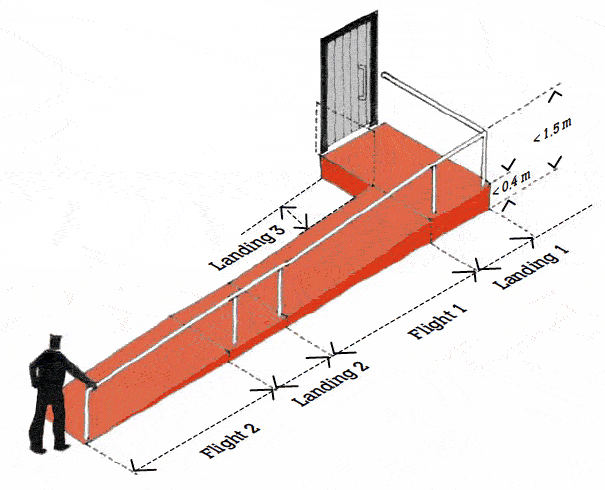
Legislation
Class 2A.-
(1) The erection, construction or alteration of any access ramp outside an external door of a dwellinghouse.
Development is not permitted by this class if-
(a) the combined length of all flights forming part of the access ramp would exceed 5 metres;
(b) the combined length of all flights and landings forming part of the access ramp would exceed 9 metres;
(c) any part of the ramp would exceed 0.4 metres in height;
(d) the combined height of the ramp and any wall (excluding any external wall of the dwellinghouse), fence, balustrade, handrail or other structure attached to it would exceed 1.5 metres; or
(e) it would be within a conservation area or within the curtilage of a listed building.
Improvements or alterations that are not an enlargement, including replacement windows, solar panels, flues, and satellite dishes etc
4.61 Permitted development rights allow any improvement, addition or other alteration to the external appearance of a dwellinghouse that is not an enlargement. This is best visualised as a 1 metre bubble surrounding the dwellinghouse. A householder can therefore carry out a wide range of different types of development without having to apply for planning permission. This class also covers the installation, alteration or replacement of solar PV or solar thermal equipment.
4.62 If the development exceeds any of the following limits then an application for planning permission is required.
4.63 The development must not enlarge the dwellinghouse. This means that the development cannot increase the internal volume of the original building. This includes a canopy or roof, with or without wall, which is attached to the building but does not include a balcony.
4.64 The development must not project by more than 1 metre from the wall or roof.
4.65 The following types of development are not permitted by this class:
- balcony, roof terrace or raised platform
- wind turbine
4.66 The following developments are also not permitted as they are permitted by other classes:
- access ramps
- a range of building or engineering operations including garden works, oil tanks
- a flue forming part of biomass heating system
- flue forming part of combined heat and power system
- air source heat pump
- CCTV
4.67 Section 6 discusses the installation, alteration or replacement of a biomass heating system flue or a combined heat and powers system flue or air source heat pump.
4.68 To ensure that the general character of an area is maintained, there is a condition that materials used for any roof covering must be similar in appearance to the existing roof. Solar PV or solar thermal panels are not considered to be a roof covering.
4.69 An alteration to the external appearance would allow the painting (or repainting) of the property. It would also allow the painting or attaching of an advertisement to the property. While an application for planning consent may not be required by virtue of this class, an application for advertisement consent may be required under the Town and Country Planning (Control of Advertisements) (Scotland) Regulations 1984 depending on the nature and size of any such advertisement.
4.70 There are no Class 2B permitted development rights in a conservation area. Listed building consent is required if the proposed development affects the character or setting of a listed building.
4.71 A building warrant from the local authority may be required, as explained in Section 2.
4.72 Planning authorities will be able to confirm whether a property is located within a conservation area. Information on listed buildings is available from http://www.historic-scotland.gov.uk/historicandlistedbuildings or www.environment.scotland.gov.uk.
Legislation
Class 2B.-
(1)Any improvement, addition or other alteration to the external appearance of a dwellinghouse that is not an enlargement.
Development is not permitted by this class if-
(a) it would protrude more than 1 metre from the outer surface of an external wall, roof plane, roof ridge or chimney of the dwellinghouse;
(b) it would be a wind turbine;
(c) it would be a balcony;
(d) it would be on the roof and would result in a raised platform or terrace;
(e) it would be within a conservation area; or
(f) it would be development described in class 2A(1), 3B(1), 6C(1), 6F(1), 6H(1) or 72(1).
(3) Development is permitted by this class subject to the condition that the materials used for any roof covering must be as similar in appearance to the existing roof covering as is reasonably practicable.
Introduction to other development within the curtilage of a dwellinghouse
4.73 There are many other types of developments that can happen within the curtilage of dwellinghouse. The following 5 classes cover the most common types of developments. Installation of microgeneration equipment is discussed in Section 6.
Ancillary buildings including sheds, garages, sun-houses, greenhouses etc.
Class 3A - The provision within the curtilage of a dwellinghouse of any building required for a purpose incidental to the enjoyment of a dwellinghouse or the maintenance or improvement of such a building.
This class generally allows the provision of any building incidental to the enjoyment of the dwellinghouse if it is in the rear curtilage. In the main this covers sheds, garages, greenhouses etc.
In the case of dwellinghouses in a conservation area, the floor area of the ancillary building cannot exceed 8 square metres (4 square metres if within the curtilage of a listed building).
Class 3A does not apply to any dwellinghouse created by virtue of class 18B or class 22A.
Class 3AA - The provision of a building of specific dimensions within the curtilage of a dwellinghouse for any purpose incidental to the enjoyment of that dwellinghouse. This class allows the provision of a storage building, no greater than 1.5 metres in height, 2.5 metres in width and 1.2 metres in depth, in the front side or rear garden of a house. It is intended to provide for storage of bikes, e-bikes, cargo bikes and adaptive bikes and mobility scooters. Class 3AA applies in a conservation area but not within the curtilage of a listed building or world heritage site. The resulting building cannot obstruct light into another building or obstruct clear sight of a road or footpath by the driver of a vehicle entering or leaving the curtilage of the dwellinghouse.
Any building, engineering, installation or other operation
Class 3B - The carrying out of any building, engineering, installation or other operation within the curtilage of a dwellinghouse, required for a purpose incidental to the enjoyment of that dwellinghouse.
This class generally allows for the carrying out of an operation within the rear curtilage of a dwellinghouse not covered by other classes. Typical development permitted by this class include free-standing solar panels, flag poles, swimming pools, oil tanks etc.
This permitted development rights does not apply in conservation areas or within the curtilage of a listed building.
Hard surface
Class 3C - The provision within the curtilage of a dwellinghouse of a hard surface for any purpose incidental to the enjoyment of the dwellinghouse or the replacement in whole or in part of such a surface.
This class generally permits the construction or replacement of a hard surface. If the hard surface is between the dwellinghouse and a road then the materials used should be permeable or, alternatively, rain water run off should be to a permeable surface within the curtilage.
This permitted development rights for hard surfaces does not apply in conservation areas or within the curtilage of a listed building.
Decking or other raised platform
Class 3D - The erection, construction, maintenance, improvement or alteration of any deck or other raised platform within the curtilage of a dwellinghouse for any purpose incidental to the enjoyment of the dwellinghouse.
This class generally permits the construction of a deck or other raised platform in the rear garden so long as the floor level does not exceed 0.5 metres and the combined height of the deck and any attached balustrade or screening does not exceed 2.5 metres.
In the case of land in a conservation area or within the curtilage of a listed building, the footprint of the deck cannot exceed 4 square metres.
Class 3D does not apply to any dwellinghouse created by virtue of class 18B or class 22A.
Gates, fences, walls or other means of enclosure
Class 3E - The erection, construction, maintenance, improvement or alteration of any gate, fence, wall or other means of enclosure any part of which would be within or would bound the curtilage of a dwellinghouse.
The overall height of the gate, fence, wall or other means of enclosure must not exceed 2 metres. However, if it fronts a road or comes forward of the principal elevation or side elevation nearest a road then it cannot exceed 1 metre. Where an existing gate, fence, wall or other means of enclosure is replaced or altered the height limit is either 1 metre or 2 metre or, if greater than these, the height of the original structure. These permitted development rights do not apply in a conservation area or within the curtilage of a listed building.
Ancillary buildings including sheds, garages, greenhouses etc
Summary
4.74 Permitted development rights allow for the provision of any building required for a purpose incidental to the enjoyment of the dwellinghouse. Typical developments include sheds, garages, sun-houses and greenhouses. In summary, the effect of the limitations is that:
- ancillary buildings are generally located to the rear
- at least half the curtilage remains undeveloped
- the height of the building is not higher than 4 metres and the sections within 1 metre of the boundary would be higher than 2.5 metres
- the height of the eaves is not higher than 3 metres
4.75 In the case of dwellinghouses in a conservation area development is permitted development as long as the footprint of the ancillary building does not exceed 8 square metres (4 square metres if within the curtilage of a listed building). Listed building consent is required if the proposed development affects the character or setting of a listed building.
4.75a Each house can also erect a single storage shed of the following maximum dimensions, in the front, side or rear garden: height 1.5 metres; depth 1.2 metres, width 2.5 metres. Specific restrictions apply to these sheds – see Class 3AA legislation box.
4.76 A building warrant from the local authority may be required for these types of developments, as explained in Section 2.
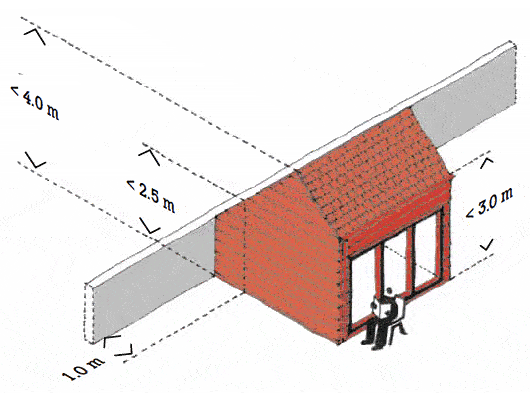
Technical Explanation
4.77 If the building exceeds any of the following limits then an application for planning permission is required.
4.78 The building cannot be used as a separate dwelling.
4.79 The building cannot be forward of a wall forming part of the principal elevation or side elevation if that elevation is fronting a road unless it is within the limits of 1.5 metres in height, 1.2 metres in depth and 1.2 metres in width (class 3AA). The identification of the principal elevation and side elevations are discussed in paragraphs 3.2 - 3.6, whilst fronting a road is discussed at 3.7 - 3.10.
4.80 This is illustrated below, the shaded areas of the curtilage indicate where an ancillary building is permitted as long as the other limitations are met.
4.81 The overall height of a building can have a significant impact on neighbours. The eaves of the building cannot be higher than 3 metres. The height of the building cannot exceed 4 metres.
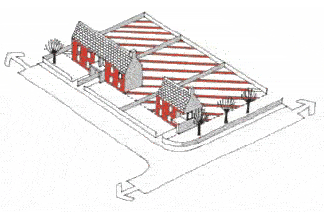
4.82 The parts of the building within 1 metre of a boundary must not be higher than 2.5 metres. This is illustrated on page 43.
4.83 When measuring the height of the development on sloping or uneven ground, the height should be measured from the lowest point immediately adjacent to the extension.
4.84 The proposed development and existing developments (including extensions, sheds, garages) cannot exceed half of the of the rear (or front if appropriate) curtilage of the original dwellinghouse, this is explained in paragraphs 3.11 - 3.12.
4.85 In the case of dwellinghouses in a conservation area, the floor area of the ancillary building cannot exceed 8 square metres (4 square metres if within the curtilage of a listed building). A listed building consent is required if the proposed development affects the character or setting of a listed building. See also Class 3AA for smaller buildings.
4.86 Planning authorities will be able to confirm whether a property is located within a conservation area. Information on listed buildings is available from www.historic-scotland.gov.uk/historicandlistedbuildings or www.environment.scotland.gov.uk.
Legislation
Class 3A.-
(1) The provision within the curtilage of a dwellinghouse of a building for any purpose incidental to the enjoyment of that dwellinghouse or the alteration, maintenance or improvement of such a building.
Development is not permitted by this class if-
(za) the dwellinghouse is a dwelling by virtue of a change of use permitted under class 18B or 22A;
(a) it consists of a dwelling;
(b) any part of the development would be forward of a wall forming part of the principal elevation or side elevation where that elevation fronts a road;
(c) the height of the eaves would exceed 3 metres;
(d) any part of the development would exceed 4 metres in height;
(e) any part of the development within 1 metre of the boundary of the curtilage of the dwellinghouse would exceed 2.5 metres in height;
(f) as a result of the development the area of ground covered by development within the front or rear curtilage of the dwellinghouse (excluding the original dwellinghouse and any hard surface or deck) would exceed 50% of the area of the front or rear curtilage respectively (excluding the ground area of the original dwellinghouse and any hard surface or deck);
(g) in the case of land within the curtilage of a listed building, the resulting building would have a footprint exceeding 4 square metres; or
(h) in the case of land in a conservation area, the resulting building would have a footprint exceeding 8 square metres.
Legislation
Class 3AA.-
1) The provision within the curtilage of a dwellinghouse of a building for any purpose incidental to the enjoyment of that dwellinghouse.
(2) Development is not permitted by this class if—
(a) the resulting building would exceed—
(i)150 centimetres in height,
(ii)120 centimetres in depth,
(iii)250 centimetres in width,
(b) there is an existing building developed by virtue of this class situated within the curtilage of the dwellinghouse,
(c) the resulting building would obstruct clear sight of a road or footpath by the driver of a vehicle entering or leaving the curtilage of the dwellinghouse,
(d) the resulting building would be situated within the curtilage of a listed building or a World Heritage Site,
(e) the resulting building would create an obstruction to light to another building.
(3) In this class “World Heritage Site” means land appearing on the World Heritage List kept under article 11(2) of the 1972 UNESCO Convention for the Protection of the World Cultural and Natural Heritage
Any building, engineering, installation or other operation
Summary
4.87 Permitted development rights allow for the carrying out of works within the rear curtilage of a dwellinghouse not covered by other classes. It is intended to apply to garden works, free-standing solar panels, flag poles, swimming pools and oil tanks. In summary, the effect of limitations is that:
- the development is generally located in the rear
- the height of the resulting structure is not higher than 3 metres
- at least half the curtilage remains undeveloped
4.88 This permitted development rights do not apply in conservation areas or within the curtilage of a listed building.
4.89 A building warrant from the local authority may be required for these types of developments, as explained in Section 2.
Technical
4.90 If the development exceeds any of the following limits then an application for planning permission is required.
4.91 Building operation is included in the description, as in terms of the definition of development and includes a wider range of development than just the provision of an actual building.
4.92 The development cannot be forward of a wall forming part of the principal elevation or side elevation if that elevation is fronting a road. The identification of the principal elevation and side elevations are discussed in paragraphs 3.2 - 3.6, whilst fronting a road is discussed at 3.7 - 3.10.
4.93 This is illustrated below, the shaded areas of the curtilage indicate where works is permitted as long as the other limitations are met.
4.94 The overall height of the development can have a significant impact on neighbours. The development cannot be higher than 3 metres. When measuring the height of the development on sloping or uneven ground, the height should be measured from the lowest point immediately adjacent to the development.
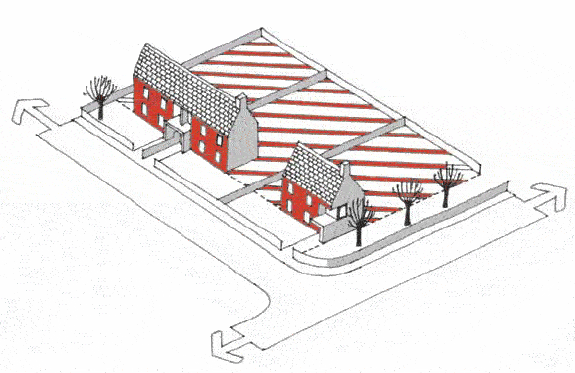
4.95 The proposed development and existing developments (including extensions, sheds, garages etc.) cannot exceed half of the rear curtilage (or front if appropriate) curtilage of the original dwellinghouse, this is explained in paragraphs 3.12 - 3.13.
4.96 The following types of development are not permitted by this class, as these types of developments are permitted by other classes:
- ancillary buildings
- hard surface
- decking
- gate, fence, wall or other means of enclosure
- ground source heat pump
- water source heatpump
- free-standing wind turbine
- air source heat pump
- means of access
4.97 There are no Class 3B permitted development rights in a conservation area or within the curtilage of a listed building. An application to the planning authority is required.
4.98 Planning authorities will be able to confirm whether a property is located within a conservation area. Information on listed buildings is available from www.historic-scotland.gov.uk/historicandlistedbuildings or www.environment.scotland.gov.uk.
Legislation
Class 3B.-
(1) The carrying out of any building, engineering, installation or other operation within the curtilage of a dwellinghouse for any purpose incidental to the enjoyment of that dwellinghouse.
Development is not permitted by this class if-
(a) any part of the development would be forward of a wall forming part of the principal elevation or side elevation where that elevation fronts a road;
(b) any resulting structure would exceed 3 metres in height;
(c) as a result of the development the area of ground covered by development within the front or rear curtilage of the dwellinghouse (excluding the original dwellinghouse and any hard surface or deck) would exceed 50% of the area of the front or rear curtilage respectively (excluding the ground area of the original dwellinghouse and any hard surface or deck);
(d) it would be within a conservation area or within the curtilage of a listed building; or
(e) it would be development described in class 3A(1), 3C(1), 3D(1), 3E(1), 6D, 6E, 6G(1), 6H(1) or 8.
Hard surface
4.99 Permitted development rights allow the construction or replacement of a hard surface within the curtilage of a dwellinghouse.
4.100 If the hard surface exceeds any of the following limits then an application for planning permission is required.
4.101 If the hard surface is located between the dwellinghouse and a road, then it must be constructed of a porous material or that provision is made for surface water run off to be directed to a porous area within the curtilage of the dwellinghouse.
4.102 This provision is introduced following a review of extreme flooding events and concerns expressed by regulatory authorities and water companies that the cumulative impact of small increases in hard surfacing is leading to increased run off into road drains that ultimately flow into watercourses or sewage treatment works. The intention of the condition is to encourage householders to adopt the principles of source control.
4.103 The Department of Communities and Local Government has produced separate guidance on permeable paving. This can be found at: www.communities.gov.uk/documents/planningandbuilding/pdf/pavingfrontgardens.pdf.
4.104 Planning permission is required for a hard surface in conservation areas and in the curtilage of listed buildings. A building warrant from the local authority may be required, as explained in Section 2.
4.105 Planning authorities will be able to confirm whether a property is located within a conservation area. Information on listed buildings is available from: www.historic-scotland.gov.uk/historicandlistedbuildings or www.environment.scotland.gov.uk.
Legislation
Class 3C.-
(1) The provision within the curtilage of a dwellinghouse of a hard surface for any purpose incidental to the enjoyment of that dwellinghouse or the replacement in whole or in part of such a surface.
(2) Development is not permitted by this class if it would be within a conservation area or within the curtilage of a listed building.
(3) Development is permitted by this class subject to the condition that where the hard surface would be located between the dwellinghouse and a road bounding the curtilage of the dwellinghouse-
(a) the hard surface must be made of porous materials; or
(b) provision must be made to direct run off water from the hard surface to a permeable or porous area or surface within the curtilage of the dwellinghouse.
Decking or other raised platform
Summary
4.106 Permitted development rights allow the erection, construction, maintenance, improvement or alteration of any deck or other raised platform within the curtilage of a dwellinghouse. In summary, the effect of the limitations is that:
- decks are generally located to the rear
- the height of the floor level does not exceed 0.5 metre
- the total height of the deck, including any attached structure does not exceed 2.5 metres
4.107 If the deck, or raised platform, is in a conservation area or within the curtilage of listed building the maximum size of the deck, or raised platform, is 4 square metres. There are no permitted development rights for flats. Nor are there any permitted development rights for a dwellinghouse created by class 18B or 22A.
4.108 A building warrant from the local authority may be required for the deck or other raised platform, as explained in Section 2.
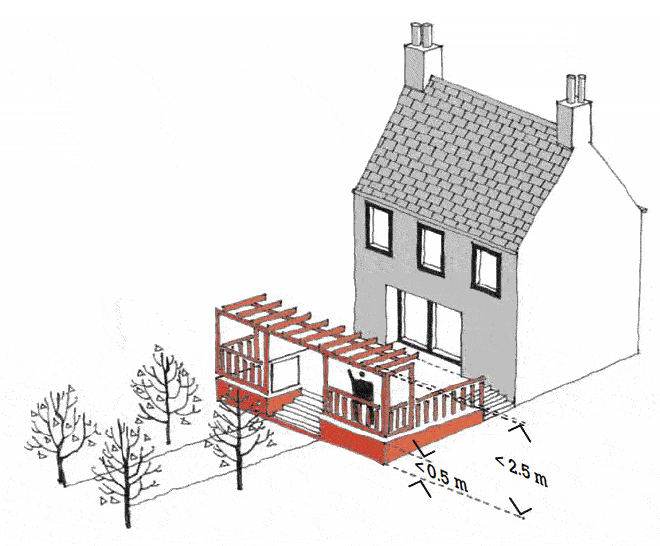
Technical Explanation
4.109 If the deck, or raised platform, exceeds any of the following limits then an application for planning permission is required.
4.110 Decks cannot be forward of a wall forming part of the principal elevation or side elevation if that elevation is fronting a road. The identification of the principal elevation and side elevations are discussed in paragraphs 3.2 - 3.6, whilst fronting a road is discussed at 3.7 - 3.10.
4.111 This is illustrated below, the shaded areas of the curtilage indicate where an extension is permitted as long as the other limitations are met.
4.112 The maximum height of the platform of the decking is 0.5 metre. The total height if, for example screens are attached, is 2.5 metres.
4.113 When measuring the height of the deck on sloping or uneven ground, the height should be measured from the lowest point immediately adjacent to the decking.
4.114 The size of decking in conservation areas and within the curtilage of listed buildings is restricted to 4 square metres to be permitted development.
4.115 Planning authorities will be able to confirm whether a property is located within a conservation area. Information on listed buildings is available from www.historic-scotland.gov.uk/historicandlistedbuildings or www.environment.scotland.gov.uk.
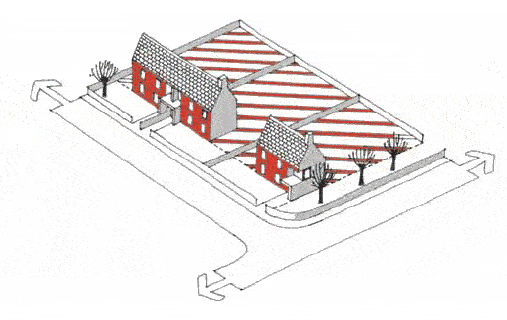
Legislation
Class 3D.-
(1) The erection, construction, maintenance, improvement or alteration of any deck or other raised platform within the curtilage of a dwellinghouse for any purpose incidental to the enjoyment of that dwellinghouse.
Development is not permitted by this class if-
(za) the dwellinghouse is a dwelling by virtue of a change of use permitted under class 18B or 22A;
(a) any part of the development would be forward of a wall forming part of the principal elevation or side elevation where that elevation fronts a road;
(b) the floor level of any part of the deck or platform would exceed 0.5 metres in height;
(c) the combined height of the deck and any wall, fence, balustrade, handrail or other structure attached to it, would exceed 2.5 metres; or
(d) in the case of land within a conservation area or within the curtilage of a listed building the deck or platform would have a footprint exceeding 4 square metres.
Gates, fences, walls or other means of enclosure
4.116 Permitted development rights allow the erection, construction, maintenance, improvement or alteration of any gate, fence, wall or other means of enclosure.
4.117 If the gate, fence, wall or other means of enclose exceeds the following limits then an application for planning permission is required.
4.118 The maximum height of any gate, fence, wall or other means of enclosure is 2 metres. Whilst its maximum height 1 metre if it fronts a road (explained in paragraphs 3.9 - 3.10) or comes forward of the principal elevation or side elevation nearest a road. Identifying the principal elevation is explained in paragraphs 3.2 - 3.6.
4.119 When measuring the height of the development on sloping or uneven ground, the height should be measured from the lowest point immediately adjacent to the gate, fence, wall or other means of enclosure.
4.120 The replacement or alteration of an existing gate, fence, wall or other means of enclosure to its original height is permitted. For example, an existing 1.2 metre fence forward of the principal elevation can be replaced with a fence up to 1.2 metres in height. If the replacement fence is higher than 1.2 metres then an application for planning permission would be required. Alternatively, if replacing a 0.8 metre high fence forward of the principal elevation it can be replaced by with a fence up to 1 metre in height.
4.121 Planning permission is needed for gates, fences, wall or other mean of enclosure in conservation areas and in the curtilage of listed buildings.
4.122 Planning authorities will be able to confirm whether a property is located within a conservation area. Information on listed buildings is available from www.historic-scotland.gov.uk/historicandlistedbuildings or www.environment.scotland.gov.uk.
Legislation
Class 3E.-
(1) The erection, construction, maintenance, improvement or alteration of any gate, fence, wall or other means of enclosure any part of which would be within or would bound the curtilage of a dwellinghouse.
Development is not permitted by this class if-
(a) any part of the resulting gate, fence, wall or other means of enclosure would exceed 2 metres in height;
(b) any part of the resulting gate, fence, wall or other means of enclosure would exceed one metre in height where it-
(i) fronts a road; or
(ii) extends beyond the line of the wall of the principal elevation or side elevation that is nearest a road;
(c) it replaces or alters an existing gate, fence, wall or other means of enclosure and exceeds whichever is the greater of the original height or the heights described in sub-paragraphs (a) and (b);
(d) it would be within a conservation area; or
(e) it would be within, or bound, the curtilage of a listed building.
Contact
Email: Chief.Planner@gov.scot
There is a problem
Thanks for your feedback